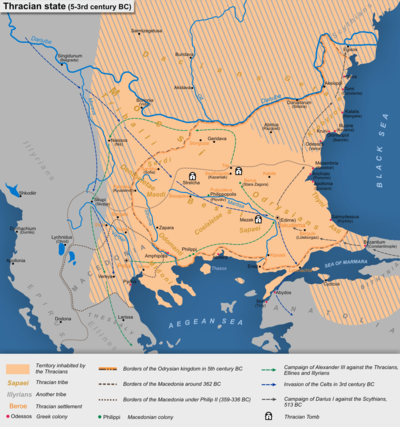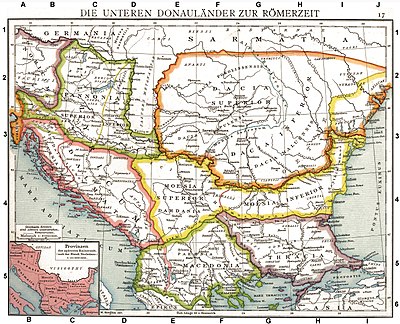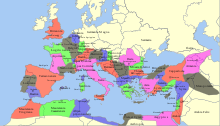Thrace
Thrace (Latin Thracia, Ancient Greek Θρᾴκη Thrakē [Ionian Θρηΐκη Thrēḯkē, epic contracted also Θρῄκη Thrḗkē], Modern Greek Θράκη Thráki, Bulgarian Тракия Trakija, Turkish Trakya), also Thrace, is a landscape in the Eastern Balkan Peninsula, now part of the states of Bulgaria, Greece and Turkey. Eastern Thrace is located in the European part of Turkey. The name of the landscape is probably derived from its inhabitants, the Thracian people.
The concepts of people and country of the Thracians are of fluctuating extent and cannot always be clearly defined both ethnically and territorially. The name of the people and the country is handed down in Homer in Ionic form: the people as θρήιχες thrḗiches, the country as θρήχη thrḗchē, and the corresponding adjective is θρήιχιος thrḗichios.
Since ancient times, the coasts of the Black Sea, the Sea of Marmara and the Aegean have been the eastern and southern borders of Thrace. The northern border was formed by the Istros (lower Danube) or later, as today, by the main ridge of the Haimos (Balkan Mountains). Since ancient times the rivers Vardar or Struma or Mesta have been mentioned as the border to Macedonia, which is situated in the west. From this results a considerable fluctuation in the extension of Thrace in northern and western direction.

Thracian territories in the 5th to 3rd centuries BC.

Southeastern Europe in Roman times
History
In antiquity, Thrace was understood to be the area north of Greece as far as the Scythians, east of Macedonia and the region of Epirus as far as the Black Sea, and populated by the Thracians, but not including Dacia and the Geats to the north. According to legend, Thrace was home to Orpheus, Dionysus and Apollo.
In 513 BC Thrace was crossed and thus conquered by the Persians under Darius I, in the process Darius married a daughter of the Getae king. The people of the Thracians formed a common empire around 450 BC. The southern parts of it were under Persian rule during the tensions of the Greek-Persian wars. During this period the Thracians broke up into many tribes of peoples. Among them the Odrysians played the leading role, often allied with Athens. In 341 B.C. the Thracians were forced to accept Macedonian domination by King Philip II. , father of Alexanderthe Great. After the death of Alexander, the territory fell to Lysimachus, who was crowned king of Thrace in 306/5 BC. In the 3rd century B.C. there was an invasion of Celtic tribes, which, however, could be defeated. A part of the remaining Celtic warriors founded a principality in Thrace around the city of Tylis and another part migrated to Anatolia (Galatians).
In 44 AD, the Roman province of Thrace (Latin Thracia) was established. The importance that Thrace had possessed for the Greek world, the country retained also in the Roman era. In Roman times, the name was used for the area between Macedonia, Illyria, the Danube and Asia Minor.
With the division of the empire in 395, Thrace became the center of the Eastern Roman or Byzantine Empire as the surrounding area of the capital Constantinople. To the west of Constantinople, the subject of Thrace was established to defend against the Bulgarians (first mentioned in 687). Before the conquest of the city in 1453, Sultan Mehmet the Conqueror had his most powerful war machines manufactured there.
In 1878, after the Congress of Berlin, the autonomous province of Eastern Rumelia was conceived within the Ottoman Empire, which took over a large part of Thrace. This was able to unite with the Principality of Bulgaria after a coup d'état in 1885. In the Balkan Wars of 1912-1913, Bulgaria also conquered western Thrace. In 1914, the Ottoman government ordered the expulsion of Greeks from Eastern Thrace, accompanied by looting. Finally, in April 1917, the last remaining Greeks were deported to Asian Turkey. In the Treaty of Sèvres in 1920, Bulgaria had to finally cede Western Thrace to Greece.
The landscape has been the namesake for Trakiya Heights, a mountain range in Grahamland on the Antarctic Peninsula, since 2010.
Timetable
| History of Thrace | |
| Year/period | Event |
| End of the 8th century BC. | Beginning of the Greek colonization on the southern Thracian coast |
| 5th century BC | Consolidation of the rule of the Odrysians in Thrace |
| 3rd quarter of the 5th century BC. | Sitalkes becomes king of the Odryses |
| 424-410 BC. | Seuthes I becomes king of the Odryses |
| ca. 383-360 B.C. | Kotys I is king of the Odrysians, after the murder of Kotys the Odrysian empire splits into three parts. |
| 342/1 BC | The Macedonian king Philip II conquers the last Odrysian sub-kingdom. |
| ca. 330-295 BC | Invasion of the Celts into Thrace, Macedonia and Ellada |
| since the end of the 2nd century B.C. | Warlike confrontation of the Romans with Thracian tribes |
| 87 BC | Lucius Cornelius Sulla Felix subdues the Thracian tribe of the Maedes |
| 74-65 BC | 3rd Mithradian War: M. Lucullus defeats the Bessians and the polis Apollonia Pontica and destroys the latter as well as Philippopolis and other Thracian cities. |
| 73-71 BC | Slave revolts in Italy under the leadership of the Thracian Spartacus |
| 29/28 BC | Moesian Wars of M. Licinius Crassus |
| 27 B.C. to 14 A.D. | Reign of the Emperor Augustus |
| 12/13 AD | After the death of the Roman-friendly Thracian king Rhoimetalkes I, the Odrysian Empire is divided by the influence of the Roman emperor. |
| At 12/15 | Establishment of the province of Moesia on the lower Danube |
| 19 | The pro-Roman Thracian king Kotys III is murdered by his uncle and counter-king Rhauskouporis. The Roman emperor Tiberius then has Rhauskouporis murdered. |
| 21 and 25 | Revolts of Thracians against the Roman rule and the Rome-friendly client king |
| 45 | The Thracian king Rhoimetalkes III, who was educated in Rome, is assassinated and the Roman province of Thrace is established. |
| 150/160 | Famine riots in the province of Thrace |
| at 170 | Incursions of the Kostoboks into the Balkan Peninsula |
| 235 | The Thracian Maximinus Thrax is proclaimed Roman Emperor by his soldiers. |
| at 240 | Beginning of the barbarian invasions of the Balkan Peninsula |
| 250/251 | Goths sack Philippopolis |
| 251 | Emperor Decius is assassinated at Abrittus in a battle with the Goths. |
| 284–305 | Emperor Diocletian carries out reforms of the administration and military organization and divides the province of Thrace into seven smaller units and visits the province several times. |
| 312/313 | Edict of Milan, by which Christianity is accepted as an equal religion |
| 330 | Foundation of Constantinople as new imperial capital |
| 364/365 | Usurpation of Procopius with the support of Gothic federates from Thrace |
| August 9 378 | Battle of Adrianople: The Roman army under Emperor Valens is devastatingly defeated, the Emperor is killed. |
| 390/391 | Devastation of Thrace by Gothic Federates |
| 1st half of the 5th century | Repeated barbarian invasions led by the Hun king Attila lead to severe devastation in the Moesian and Thracian provinces. |
| approx. 493 | Appearance of the first Bulgarians south of the Danube |
| approx. 520 | Arrival of the first Slavs on the Balkan Peninsula |
| 527–565 | Reign of Emperor Justinian I, who had the destroyed cities in Thrace rebuilt and fortified. |
| approx. 580-600 | Wars with the Avars and the Slavs allied with them, ending with the abandonment of the border provinces on the Danube |
| 678 | Settlement of the Bulgarians under Asparuch north of the Balkan Mountains |
| 680/681 | Treaty recognition of the Bulgarian Empire by the Byzantine Emperor Constantine IV. |
| 8th to 14th century | Thrace as a border region is constantly threatened by the warlike conflicts between Bulgarians and Byzantines. |
| 1453 | After conquering Bulgarian Thrace in 1396, the Ottoman Empire conquered Constantinople and the last Byzantine territories of Thrace in 1453. |

The Roman provinces under Trajan (117 AD)

Odrysian state in the 4th century BC.
Thracian culture
→ Main article: Thracian culture
Thrace, as "the golden kingdom of Orpheus" (Homer), is one of the oldest cultural landscapes in Europe and famous for its philosophers. Everywhere in Thrace, especially in the Upper Thracian Plain, one can come across the remains of ancient cultures and historical places. Many of them are hardly explored and little known. In the landscape you can see Thracian dolmens and tumuli (Thracian royal tombs).
Questions and Answers
Q: What is Thrace?
A: Thrace is a historical and geographic area in southeast Europe.
Q: What is the location of Thrace?
A: Thrace is bounded by the Balkan Mountains on the north, Rhodope Mountains and the Aegean Sea on the south, and by the Black Sea and the Sea of Marmara on the east.
Q: Which regions are included in Thrace?
A: Thrace included areas which are now southeastern Bulgaria, northeastern Greece, and the European part of Turkey.
Q: Who were the inhabitants of Thrace?
A: The Thracians were an ancient Indo-European people.
Q: Where did the Thracians live?
A: The Thracians lived in Central, Eastern and Southeastern Europe.
Q: When did the Thracians live?
A: The Thracians were an ancient people, but there is no specific time period mentioned in the text.
Q: What are some of the prominent geographical features of Thrace?
A: Thrace is bounded by the Balkan Mountains on the north, Rhodope Mountains and the Aegean Sea on the south, and by the Black Sea and the Sea of Marmara on the east.
Search within the encyclopedia